The Arduino is arguably one of the best things to come to the “Maker” Renaissance that we are currently experiencing. The Arduino is a simple microcontroller that can allow the one who wields it great power and programmatic control over their electronic circuits and systems. Yet to be a great wizard of such things, one must start at the humble beginnings of the very basics.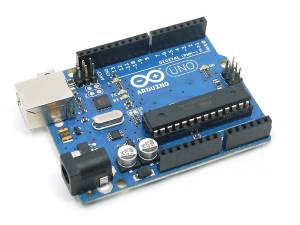 What better way to get started than with an Arduino starter kit? That’s the trick, though, isn’t it? There’s more than one starter kit out there!
What better way to get started than with an Arduino starter kit? That’s the trick, though, isn’t it? There’s more than one starter kit out there!
First Impressions
This review originally covered 3 of the most popular Arduino kits on the market, but we added 1 more:
- The Official Arduino Starter Kit
- The Sunfounder Super Kit
- The Vilros Ultimate Starter Kit / SparkFun Inventors Kit
- The ARDX Starter Kit for Arduino
Update 10/10: It was discovered that the Vilros kit is a clone of the SparkFun Inventors Kit. How did they get away with this? Well, SparkFun released their manual under the CreativeCommons ShareAlike license. So Vilros took the manual and slapped their name on it, but still credited SparkFun on the back of the manual. It appears to be within their legal right to do this since they’ve attributed SparkFun as the original author.
Update 10/19: ARDX kit added to comparison.
Official Arduino Starter kit
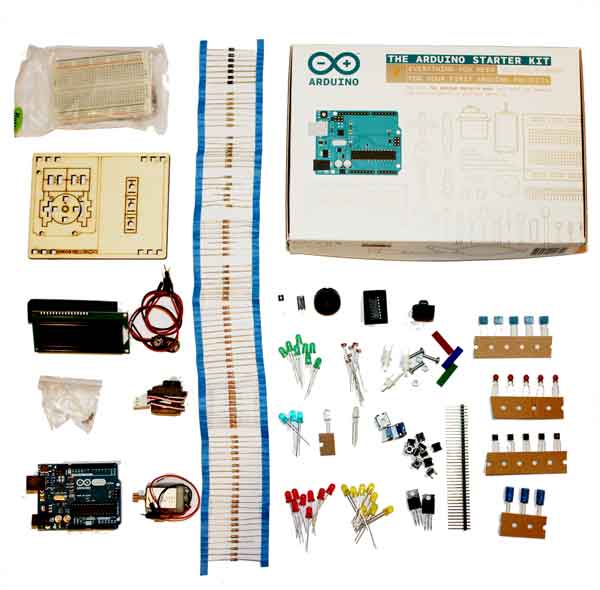 The niceness of the Official Arduino Starter kit is like opening an Apple product. The box feels special. Open the box and there is a nice plush manual inside. Underneath the manual is a set of neatly packaged copper colored boxes each with a different component or set of parts. It feels like you are getting something special. And, well, a starter kit IS something special. The breadboard and the Arduino are mounted on a thin piece of pine which has been laser-cut and which requires a little assembly. The only frustration with this kit is once you have everything assembled, it doesn’t all go back neatly in the box.
The niceness of the Official Arduino Starter kit is like opening an Apple product. The box feels special. Open the box and there is a nice plush manual inside. Underneath the manual is a set of neatly packaged copper colored boxes each with a different component or set of parts. It feels like you are getting something special. And, well, a starter kit IS something special. The breadboard and the Arduino are mounted on a thin piece of pine which has been laser-cut and which requires a little assembly. The only frustration with this kit is once you have everything assembled, it doesn’t all go back neatly in the box.
Vilros Ultimate Starter Kit / SparkFun Inventors Kit
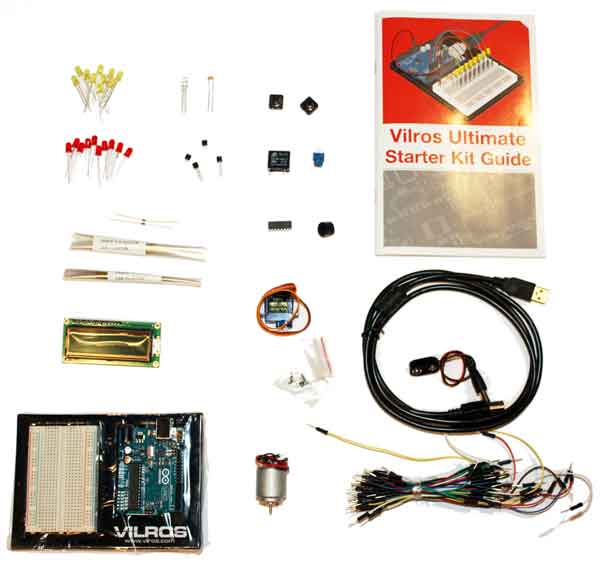 The Vilros Ultimate Starter kit is unimpressive on the outside. It’s a simple, white cardboard box with a white label that says “Arduino Uno Rev3 Ultimate Starter Kit +LCD module” — Opening the rather bland box reveals a manual, some parts, and a plastic tray to mount the breadboard and the Arduino. While not the most impressive thing ever, at least everything can fit back in the box when you’re done fiddling for the day. And that’s actually pretty important.
The Vilros Ultimate Starter kit is unimpressive on the outside. It’s a simple, white cardboard box with a white label that says “Arduino Uno Rev3 Ultimate Starter Kit +LCD module” — Opening the rather bland box reveals a manual, some parts, and a plastic tray to mount the breadboard and the Arduino. While not the most impressive thing ever, at least everything can fit back in the box when you’re done fiddling for the day. And that’s actually pretty important.
The same parts are found in the SparkFun Inventors Kit. The difference? SparkFun charges top dollar for their kit. Same parts and nearly the same manual.
Sunfounder Super Kit
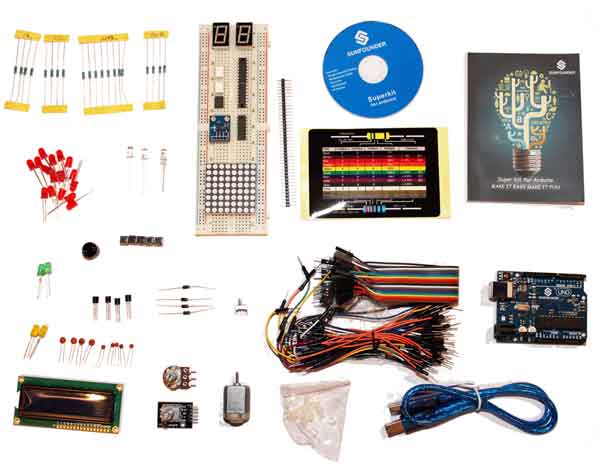 The Sunfounder Super kit is a small package featuring a fancy blue and white circuit/microchip motif and the Sunfounder logo. It looks like someone took the time to at least design an interesting package. Inside was a tiny manual, a mini DVD, a resistor cheat-sheet sticker, and an oddly curious paper slip with some emoji characters explaining that you should contact Sunfounder support if you have any problems. Underneath this is a translucent blue box with all the components crammed inside. Can you put everything back when done fiddling for the day? Sure, but not easily. A bigger plastic box would have been nicer.
The Sunfounder Super kit is a small package featuring a fancy blue and white circuit/microchip motif and the Sunfounder logo. It looks like someone took the time to at least design an interesting package. Inside was a tiny manual, a mini DVD, a resistor cheat-sheet sticker, and an oddly curious paper slip with some emoji characters explaining that you should contact Sunfounder support if you have any problems. Underneath this is a translucent blue box with all the components crammed inside. Can you put everything back when done fiddling for the day? Sure, but not easily. A bigger plastic box would have been nicer.
ARDX Starter kit for Arduino
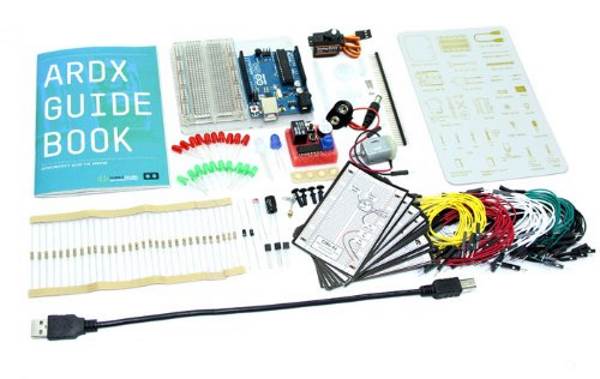 The ARDX Starter kit for Arduino is much like the Sunfounder kit in that it comes in a small plastic green box. Everything is packed tightly in the box with a manual, cheat sheet, and parts. It also contained some clever paper overlays for the breadboard to help place parts and wires more easily. This was a nice touch.
The ARDX Starter kit for Arduino is much like the Sunfounder kit in that it comes in a small plastic green box. Everything is packed tightly in the box with a manual, cheat sheet, and parts. It also contained some clever paper overlays for the breadboard to help place parts and wires more easily. This was a nice touch.
“What’s in the box?”
| Official Arduino Starter Kit | Vilros Ultimate Starter Kit / SparkFun Inventors Kit | Sunfounder Super Kit | The ARDX Starter kit for Arduino | |
| Price | $86 | $63 (Vilros) / $99 (SparkFun) | $50 | $60 |
| Projects | 15 | 12 | 19 | 13 |
| Arduino | Genuine UNO R3 | Genuine UNO R3 | Sunfounder UNO R3 | Genuine UNO R3 |
| Chip | Atmega 328P | Atmega 328P | Atmega 328P | Atmega 328P |
| Breadboard | 30-row | 30-row | 60-row | 30-row |
| LCD | 16×2 char | 16×2 char | 16×2 char | – |
| LEDs | 8 Red, 8 Green, 8 Yellow, 3 Blue, 1 White, 1 RGB | 10 Red, 10 Yellow, 1 RGB | 16 Red, 2 Green, 2 Yellow, 2 White, 1 RGB | 12 Red, 13 Green, 2 Yellow, 1 RGB |
| Optocoupler | 1 | – | 2 | – |
| Potentiometers | 3 | 1 | 1 | 1 |
| Pushbuttons | 10 | 2 | 5 | 3 |
| DC Motor | Y | Y | Y | Y |
| Piezo | Y | Y | Y | Y |
| Servo | Y | Y | – | Y |
| Temp Sensor | Y | Y | – | Y |
| Photoresistors | Y | Y | – | Y |
| H-bridge IC | Y | Y | Y | Y |
| Tilt Sensor | Y | – | – | – |
| Relay | – | Y | – | Y |
| Accelerometer | – | – | Y | – |
| 7-seg display | – | – | Y | – |
| 8×8 Dot Matrix LED | – | – | Y | – |
| 555 timer | – | – | Y | – |
Looking at the first few rows in the table, all 3 kits look about the same. They all have a project manual with a dozen or so projects, Arduino, breadboard, 16×2 LCD display, and a handful of different colored LEDs (some more and varied than others.) The “Official” kit seemingly being the most well-equipped.
In terms of special items of interest, the Official Arduino Kit, the SparkFun kit, the ARDX kit, and the Vilros kit have a Servo, Temperature sensor, Photoresistors, H-bridge ICs, and either a Tilt Sensor or a Relay.
The Sunfounder kit attempts to distinguish itself by going in a different direction and including special items such as an Accelerometer, 7-segment LED displays, an 8×8 dot matrix LED display, and (of all things) a 555 timer!
A walk down memory lane
Looking at all these special components reminded me of those 160-in-1 electronics kits you could get from Radio Shack like the one shown below:
Interestingly enough, this image was found posted in the Parallax “maker” forum where a user, Jeff, reminisced about how awesome the electronics kits were as a kid. Specifically, he wrote why he thought they were so great:
It was the book that came with them! There was 160+ projects you could create by simply connecting one wire at a time, following the little instruction. You could build something really cool, then go off and show the project to relatives, and friends and get some bragging rights. You didn't even have to understand how the circuit worked to play.
And that was it! The book is what really helps you learn and make all of this fun. It was NOT all the things you were going to get in the kit, but what you were going to DO with them!
Comparing the Guides
The Arduino Projects Book
This guide is included in the official Arduino kit. The book itself is very polished and well put together. The cover of the book is embossed and it smells nice. The front and back flaps have large folds which you can use to hold your place in the book. Definitely a professionally produced book.
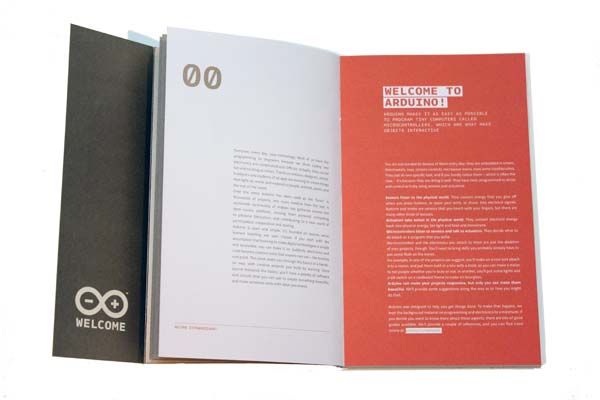 Opening the first few pages reveals a welcome and introduction to what Arduino is. The pages quickly lead into an overview of what should be in the box, how to assemble the basic setup, and what various pieces and parts in the kit are (as well as their electrical diagrams.)
Opening the first few pages reveals a welcome and introduction to what Arduino is. The pages quickly lead into an overview of what should be in the box, how to assemble the basic setup, and what various pieces and parts in the kit are (as well as their electrical diagrams.)
That said, the early chapters are not as clear as they could be. Often times a word of jargon was used in the text before the word was defined. Granted, a good reader will know to “sit tight” as the definition is certain to come, but for neophytes, this can be a little disconcerting. 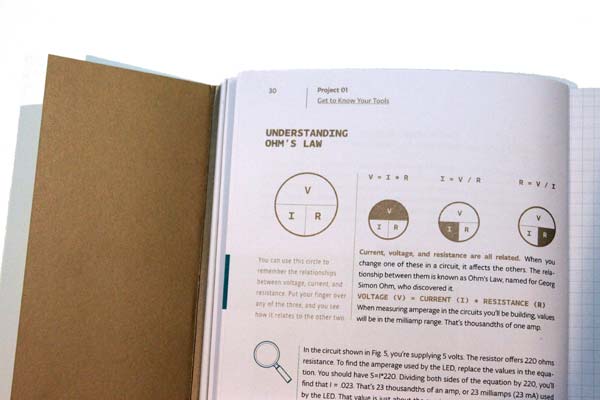
The book *does* certainly take the time to talk about Voltage and Current and tries to explain this concept as well as Ohm’s law, which was a good sign. Yet, the feeling that an electrical engineer writing this for a 1st year electrical engineering university student was a bit inescapable. Would a HS or Middle school student understand all of this? Maybe, maybe not.
Maybe it didn’t matter as long as fun was had.
The book starts off showing how to light up an LED with a push button and then advances to using the digital outs to show how to light up multiple LEDs using a simple Arduino script. By mid-book, the guide gets into Pulse Width Modulation (PWM) — an important concept in digital signalling and control in order to make a simple theremin with the piezo electric speaker.
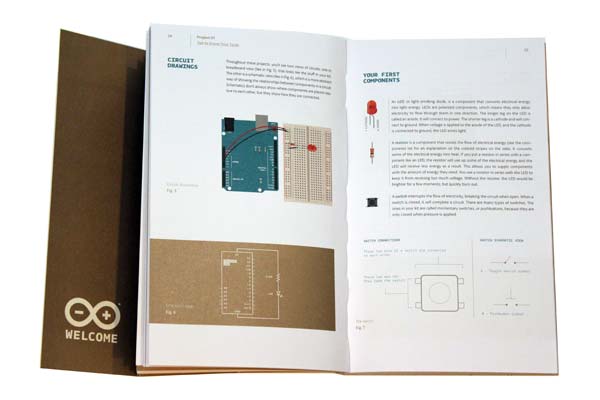 Every chapter is clear enough that the person doing the project knows what parts are needed and where to put the parts on the Arduino or on the breadboard. The book also explains code line-by-line, yet doesn’t spend a lot of time talking about certain aspects of the code. For example, it talks about an “unsigned long”, but doesn’t explain what an unsigned long is. For programmers, this is obvious. For people new to programming, this is just more jargon to get tripped up on.
Every chapter is clear enough that the person doing the project knows what parts are needed and where to put the parts on the Arduino or on the breadboard. The book also explains code line-by-line, yet doesn’t spend a lot of time talking about certain aspects of the code. For example, it talks about an “unsigned long”, but doesn’t explain what an unsigned long is. For programmers, this is obvious. For people new to programming, this is just more jargon to get tripped up on.
The sense that this book was for advanced high school or beginning university students remained. This book would be pretty difficult for people without at least a little bit of computer programming experience and a smattering of electronics experience.
The Vilros Ultimate Starter Kit Guide
This book was written by the well-known electronics/maker website, SparkFun. The guide does not quite carry the same amount of physical cachet as the official Arduino starter guide, but it is very clear that a great deal of thought and consideration was put into creating this. The fonts, while less fancy, were much easier to read. The layout was also a bit more pleasing. The “inventory” of what was supposed to be in the kit was abundantly clear.
The next 2 pages were dedicated to explaining exactly the layout of the Arduino as well as what each pin did. The following 2 pages then clearly displayed what a breadboard was and how it worked. This was entirely unexpected, but very welcome.
There was a sense that the team of people that wrote this guide knew that not everyone has a degree in electrical engineering and that some things like the pin-outs for the Arduino and how a breadboard was not something that everyone would understand instantly. This was very reassuring.
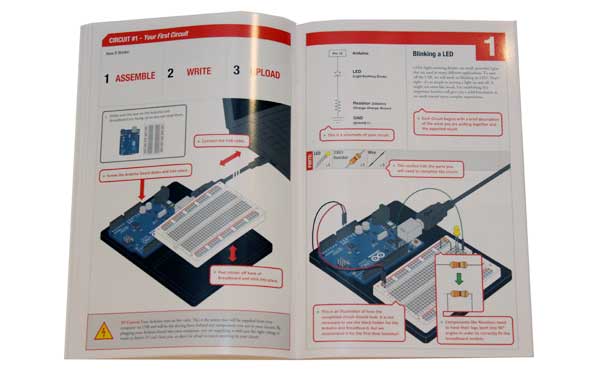 This guide also has a superior way of showing what and how everything was going to be performed. On the first page of a project, it gives a quick overview of the project including the electrical schematic and a pseudo 3D style for displaying how to wire everything up.
This guide also has a superior way of showing what and how everything was going to be performed. On the first page of a project, it gives a quick overview of the project including the electrical schematic and a pseudo 3D style for displaying how to wire everything up.
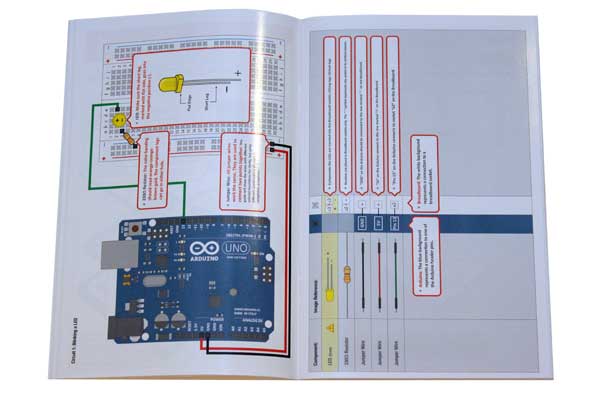 On the next 2 pages, it shows a 2D wiring diagram with a parts list and what is going on “behind the scenes”. The last page or two show what code is to be used, what you should expect to see, and how to troubleshoot your system if you run into problems.
On the next 2 pages, it shows a 2D wiring diagram with a parts list and what is going on “behind the scenes”. The last page or two show what code is to be used, what you should expect to see, and how to troubleshoot your system if you run into problems.
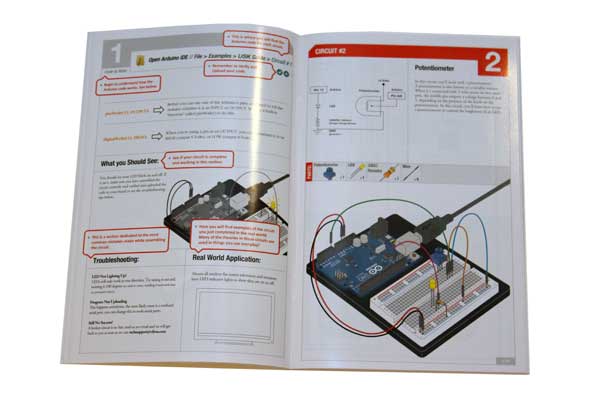 Was it fun? Yeah, it was pretty fun. Not quite as fun as the official Arduino kit, but still a lot of fun. And the part that really seemed important:
Was it fun? Yeah, it was pretty fun. Not quite as fun as the official Arduino kit, but still a lot of fun. And the part that really seemed important:
It was pretty easy to understand. Learning was happening!
Sunfounder Super kit for Arduino guide
The most striking thing about this guide was that it was a mere 3.5″ x 4.5″ (8.5cm x 11.5cm) and not very thick. The cover of the guide read “MAKE IT EASY MAKE IT FUN” in the much reviled Comic Sans font. If this was an indicator of things to come, this did not bode well for the Sunfounder Super Kit.
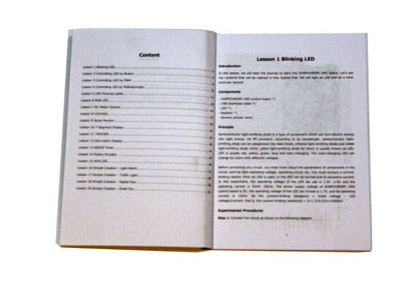 First page? A short preface in an utterly tiny font (each character measured about 1mm across.) Second page was the table of contents, and the 3rd page was the very first experiment. Talk about getting down to business!
First page? A short preface in an utterly tiny font (each character measured about 1mm across.) Second page was the table of contents, and the 3rd page was the very first experiment. Talk about getting down to business!
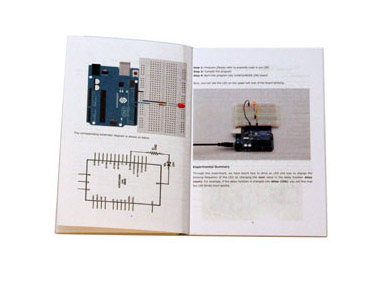 A typical experiment in this guide goes as follows. Quick introduction, list of components needed, a little talk about electronics theory, a wiring diagram of the Arduino and breadboard, and a small picture of the electrical schematic. Then it tells you to download the code from the CD, compile it, debug it (excuse me?), then write it out to the Arduino.
A typical experiment in this guide goes as follows. Quick introduction, list of components needed, a little talk about electronics theory, a wiring diagram of the Arduino and breadboard, and a small picture of the electrical schematic. Then it tells you to download the code from the CD, compile it, debug it (excuse me?), then write it out to the Arduino.
Absolutely zero time is spent talking about what the code actually does.
This was quite disappointing because building things with the Arduino is about 2 things:
- Building electrical circuits
- Controlling them with a microchip
In essence, this guide covers part 1 (electrical circuits) and glosses over part 2 (programming). This is okay if the reader is already a well-versed programmer and just wants to pick up electronics quickly, but not so great for people with little-to-no programming skill.
ARDX Guide Book
The ARDX Guide Book is a mixed bag. It does not have the same level of polish that the SparkFun or the Official Arduino guide have, but it is not nearly as slap-dash as the SunFounder manual.
On the plus side, the guide had very clear assembly instructions, much like the SparkFun manual.
It also took the time to explain the difference between an int and a float, as well as programming syntax. Although the explanation was rather brief, it was sufficient.
On the minus side, the code discussion was rather short. In fact, everything in the manul was rather brief. Not quite as short as the SunFounder guide, but after reading through each experiment, it seemed as if there should have been at least a whole extra page of talk and explanation that just wasn’t there.
Conclusion
Best Arduino Kit for complete Beginners
The kit that truly put the most effort into making it easy to learn how to use the Arduino is the SparkFun Inventors Kit ($99) and the Vilros Ultimate Starter Kit ($63). While it didn’t have quite the polish that the “official” kit had, like the Millenium Falcon, “It’s got it where it counts, kid.” The guide is what made this kit. It was clear, well-written, and easy to understand. And it was fun, too! This is the right choice for complete beginners.
Best Arduino Kit for Makers with some experience
For people with at least some programming and/or electronics experience, the Official Arduino Starter kit ($86) is a good choice. The guide is professionally written and edited, but definitely targets a somewhat educated audience. Despite this, the kit contains 15 different projects, all of which were enjoyable. This is definitely the right choice for advanced high schoolers or those with university level education.
Best Arduino Kit for Programmers who want more Electronics experience
Those who already have a lot of programming skill under their belts will want to take a look at the Sunfounder Super kit ($50). The guide in this book presumes a modestly strong understanding of the principles of programming and does not take a ton of time to explain things in detail. This kit contained 19 projects and had a variety of different components to play with. In fact, I would expect that a person picking up this kit may already have an Arduino. If this is the case, the Sunfounder Super kit without the Arduino included is probably the better choice as it brings the price down to a low $35.
What about the ARDX kit?
The ARDX kit ($60) falls somewhere between “the kit for Makers with some experience” and “the kit for Programmers”. It makes the basics pretty easy, but shortchanges the reader on good detailed explanations. This isn’t to say that the explanations aren’t there. They are. It’s just that they could be better. The value of this kit was also the poorest. At $60, one should expect a little more in both parts, projects, and manual.
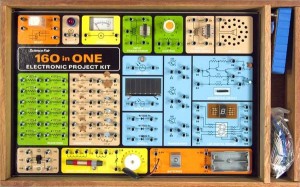
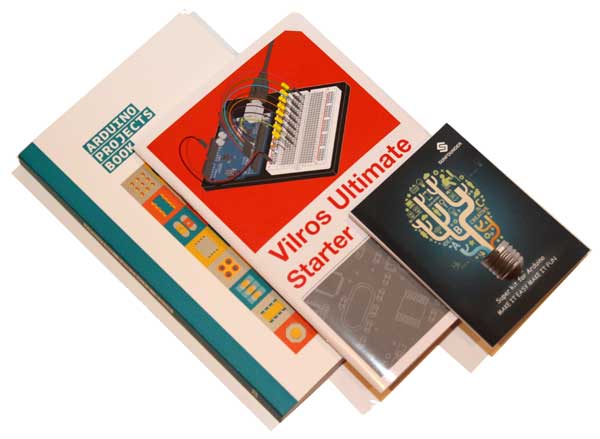
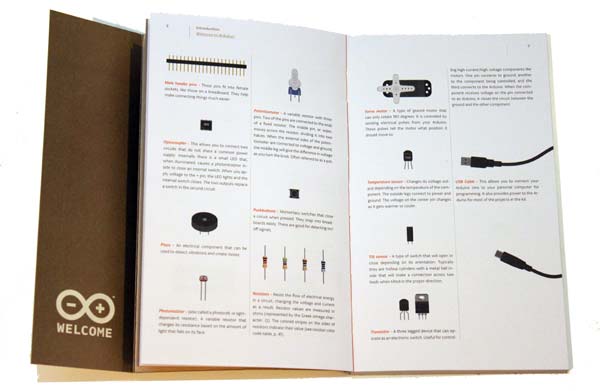
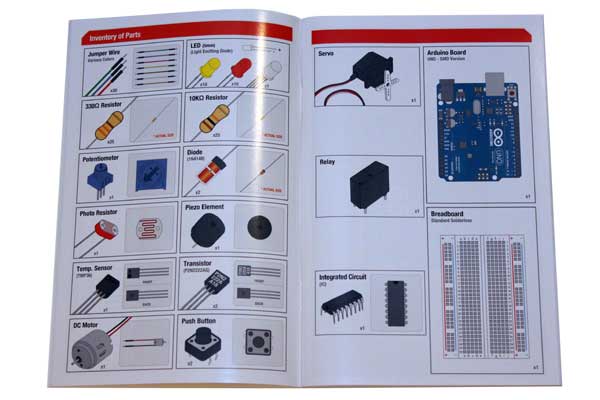
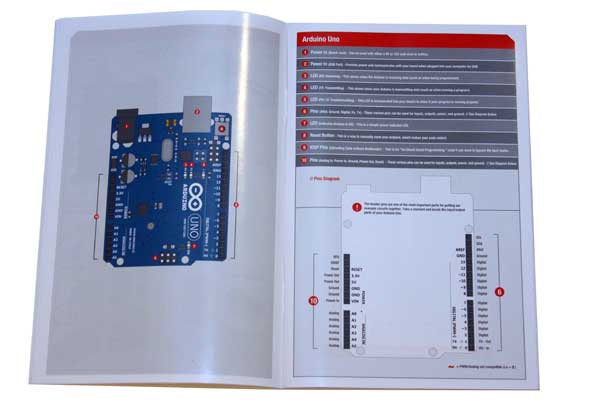
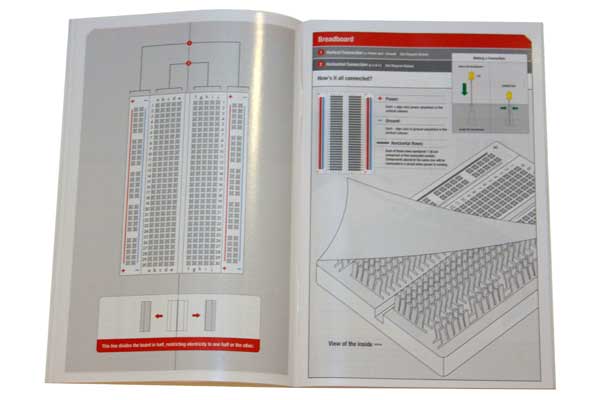
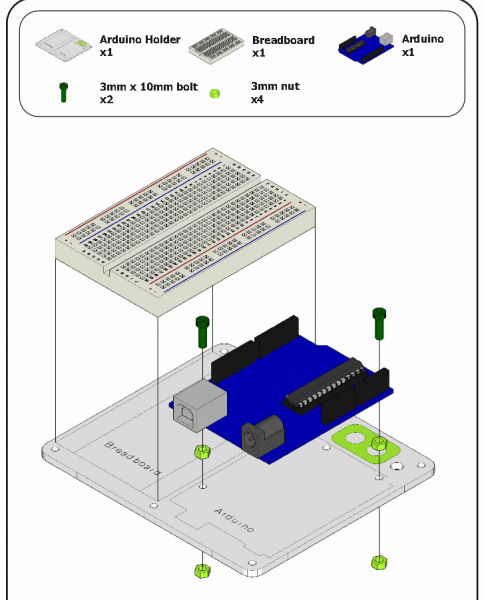
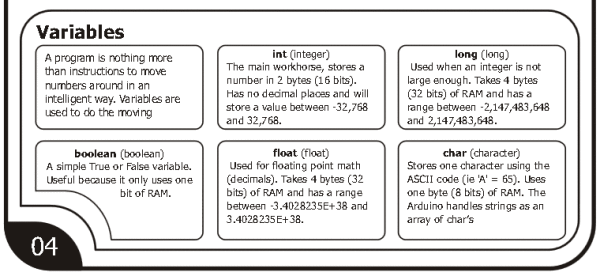
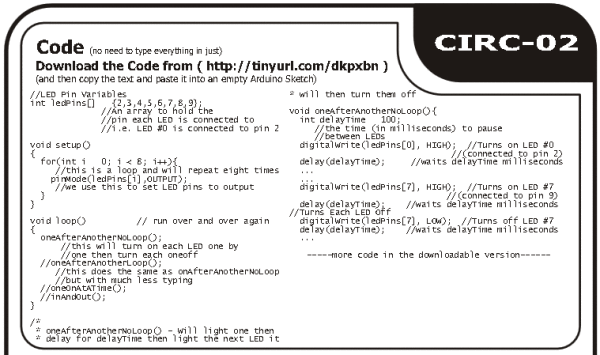

21 replies on “The best Arduino starter kits compared and reviewed”
This was a really well done review! I appreciated the thoroughness and thought you put into it. I’d already bought the official kit, but I was generally happy with it aside from some issues with the potentiometers sitting funny in the breadboard. I’ll definitely send people here if they’re getting started.
Hey! Thanks for the compliment. It’s much appreciated. I checked out your site and I really liked your article on “3 things the writing community can learn from the music scene.” Good stuff! Especially the last point about the fans being so important. That’s very salient. 🙂
Great article(and name by the way)! I was looking for exactly this. Someone who did a comparison of each in a detailed way and you nailed it! I was tempted by the official one but didn’t like the price. I went with the Sunfounder one because I am a Senior majoring in CS so the lack of programming explanation shouldnt be a problem. Just out of curiosity, which is your favorite of the three?
Hooray for Pretzels! Thanks. Yeah, this was a fun review. I wasn’t sure how well it would be received, but apparently there’s been a lot of curiosity around Arduino, so timing was good. Of the 3, the SparkFun manual was my favorite, but not for the reason you may think. I seem to recall as a young boy wanting to learn about electronics badly, but there really wasn’t anyone to teach me. So I struggled thru the electronics kit manuals, but there were still parts that weren’t that well written that didn’t explain things well. Like transistors, for example. They’re actually rather simple to use, once you understand them, but it’s hard to explain well. Frankly, the SparkFun manual does this the best. It really *does* take the time to lay things out slowly and methodically. It might be boring for someone who just wants to have fun or who already has electronics under their belt pretty well, but I thought it was a great manual for the absolute beginner.
Thanks for the review! I spent a couple of hours browsing through descriptions/critiques of kits and found it difficult to find one that:
1–is current, and
2–appeared unbiased.
One suggestion: In your “What’s in the box” you might have included a couple of lines of “What’s NOT in the box.” None explain stepper motors, for example.
That was totally well presented. Love it. Well, I’m doing my undergraduate in electronics. I was thinking to buy the ‘ Vilros Ultimate Starter Kit ‘ , and later on buy and assemble the other components like accelerometer, 7-segment LED displays, an 8×8 dot matrix LED display , tilt Sensor , optocoupler (those things that Virlos kit doesn’t have in it). What do u think..?
Seems like a reasonable approach to me. Although, maybe by the time you’re done working thru the Vilros kit, you’ll have ideas of your own that you’ll want to try! 🙂
Echo Cody and others. Well written, and not just a list of parts vs price, but the main thing – the fun.
Was wondering what to get – not now!
Cheers!
c
A relative got me a great kit from Earthshine Electronics several years ago which had a downloadable pdf manual (which was a very good manual and a precursor to the author filling it out even more to be a book on Amazon apparently). I just checked and he doesn’t sell the kit anymore, (which is too bad) but you can still get his very good PDF at his site (and others) for free. Here’s the link to his site with the pdf link on that page:
http://thearduinoguy.org/?page_id=100
You’ll see the pdf download link on that page.
[…] micro-controller has capacity to allow programming and experimentation beyond most expectations. Reviews and comparisons often mention that the true value is in the accompanying manual. The manual leads a beginner […]
Terrific review – thanks for taking the time to do it. I was leaning towards the official kit as something to get our teeth into this summer with my son who starts middle school next year…. but after reading your article, it seems like the SparkFun/Vilros option would be a better choice (ultimately, will probably end up with both, since neither costs a bomb). Thanks & have a great summer!
Thank you for contributing such a detailed comparison. I was confused choosing between the starter kits available online for my first project and the details in the article helped me to pick the one for my skill.
Cheers!
Is it possible to purchase the sun founder starter kit and a separate arduino board and combine the parts or one with the other?
If I understand your question correctly, yes, there is a Sunfounder kit without the Arduino (~$30): http://amzn.to/1FnCakk
Then you take any Arduino and it should work fine with the rest of the kit.
Great explanation, i find it very hard to make a decision between those kits and buying loose parts. But stil cant decide or to go for the official kit or the Sparkfun kit, the Villros option isn’t available in my country.
This is the best review of the kits on the internet!
thanks for making a complete review of the most popular kits on the market….!!!
I have a good understanding of electronics but no programming skills at all….
your article really gives me an idea of what to consider when choosing one of them.
Again…..thanks !
augusto.
Thanks so much for your review. It was very informative and well executed. Thanks for putting so much time in.
I have no experience with Arduino, but I am very interested. Your review pointed out that the vilros starter kit had the best manual….
I guess I am a little torn. I like all the add-ons that come in the Sunfounder kits. So, is there a book out there that would make up for the poor documentation of the sunfouner manual? Or perhaps, is there a good add-on kit that I could add to the vilros one to have the variety of equipment?
I’d say buy the Vilros kit and learn how to use the Arduino properly. And if you want the Sunfounder parts, I think you can buy a stand-alone Sunfounder kit without the Arduino later.
the sunfounder seem to have improved the guide
https://www.sunfounder.com/learn/Super-Kit-V2-0-for-Arduino/lesson-1-blinking-led-super-kit.html
and the cover looks different too
http://www.amazon.com/Sunfounder-Project-Starter-Arduino-Mega2560/dp/B00D9M4BQU/tag=pretze-20#customerReviews
hmm, thought about the official kit before. but after reading this, maybe more need another one.
Hi, excellent review. Just what I was looking for. Do you know where you can buy the Official Arduino Starter Kit. I cant find the one with the same box. Have they changed the box?
Manjeet5585
Very good and instructive article, i would also propose to have a look at the two kits from Elecfreaks
Starter Kit :
http://amzn.to/2jt6SVg
Advanced Kit:
http://amzn.to/2koYKoC
Both seems awesome.